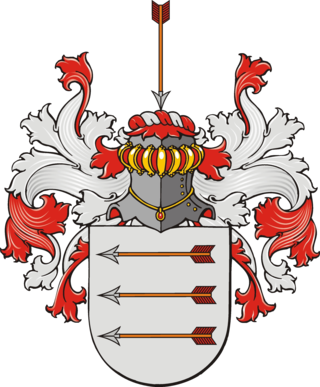
George Wilhelm Kettmann or George Kettmann Jr. was a Dutch poet, writer, journalist and publisher who promoted Nazism in the Netherlands. With his wife, he founded the best known Dutch Nazi publishing house, De Amsterdamsche Keurkamer. Until 1941 he was editor in chief of Volk en Vaderland, the weekly journal of the National Socialist Movement in the Netherlands (NSB), the movement of Anton Mussert.

Floris Adriaan van Hall, Baron of Hall was a prominent Dutch nobleman and statesman in the 19th century. He played an important role as representative of the Amsterdam trade and banking sector, and later as politician. He served as Prime Minister of the Netherlands from 1853 to 1856, and again from 1860 to 1861.

Cornelis Pietersz. Hooft was a Dutch statesman and Amsterdam regent during the Golden Age.

Cornelis Felix van Maanen was a Dutch minister and jurist.
Van Maanen is a Dutch toponymic surname meaning "from Manen", a former town in Gelderland now part of Ede. Variants include Van Manen and Van Maenen. People with this name include:

The Nationaal Archief (NA) is the national archives of the Netherlands, located in The Hague. It houses collections for the central government, the province of South Holland, and the former County of Holland. There is also material from private institutions and individuals with an association to the Dutch government or the political or social history of the Netherlands. The Nationaal Archief holds the Archives of the Dutch East India Company from 1602–1811, which were, along with related records held by South Africa, India, Sri Lanka and Indonesia, inscribed on UNESCO's Memory of the World Programme Register in 2003 in recognition of their historical value. Recently, the photographic archives of Spaarnestad Photo were included in the Nationaal Archief. It has been announced that Wikipedia will receive user rights over many photos from these archives.

De Graeff is an old Dutch patrician and noble family,

Gerrit de Graeff, vrijheer van Zuid-Polsbroek, Purmerland and Ilpendam was a member of the influential De Graeff family of Amsterdam. He belonged to the patrician class of the city and held the feudal titles Free Lord of Zuid-Polsbroek as those of Purmerland and Ilpendam.
Nederland's Patriciaat, informally known as Het Blauwe Boekje, is a book series published annually since 1910, containing the genealogies of important Dutch patrician non-noble families. It is published by the Centraal Bureau voor Genealogie (CBG) in The Hague. The Publication Commission of the CBG determines which families are included. The publication was modelled after the Genealogisches Handbuch bürgerlicher Familien.

The CBG Centrum voor familiegeschiedenis(formerly called: Centraal Bureau voor Genealogie) (CBG) is the Dutch research centre for genealogical and heraldic studies. It is a non-profit foundation that has been founded on May 15, 1945, with the aim of bringing together a number of archive collections and making research of genealogy and related studies easier. The centre is located at the Prins Willem Alexanderhof in The Hague together with the National Archive.

Jacob de Graeff was a member of the De Graeff-family from the Dutch Golden Age. He was an Amsterdam regent and held the title as 20th Free Lord of Ilpendam and Purmerland.
De Witt is the name of an old Dutch patrician and regenten family. Originally from Dordrecht, the genealogy of the family begins with Jan de Witte, a patrician who lived around 1295. The family have played an important role during the Dutch Golden Age. They were at the centre of Dordrecht and Holland oligarchy from the end of the 16th century until 1672, and belonged to the Dutch States Party.

Van Vloten is a Dutch patrician family from Vleuten.

Anton August van Vloten was a Dutch agriculturalist. He was the founder of the Maarsseveense Stoomzuivelfabriek and director of the Waterschap Bethune water board. He also was alderman of Maarsseveen.

Jan Hoynck van Papendrecht was a Dutch painter and illustrator, famed for his military art.

Allart Pieter van Jongestall, also spelled Allard Pieter van Jongestal was a Dutch jurist and diplomat. He was president of the Hof van Friesland and represented the States-General of the Dutch Republic in the negotiations of the Treaty of Westminster (1654) and the Treaty of Breda (1667) which ended the first two Anglo-Dutch Wars.

Baron Pieter van Reedevan Oudtshoorn was a senior official and Governor designate of the Dutch Cape Colony. He was appointed Governor of the Cape Colony in 1772 to succeed the deceased Governor Ryk Tulbagh but died at sea on his way to the Cape Colony to take up his post. The Western Cape town of Oudtshoorn is named after him. He is the progenitor of the van R(h)eede van Oudtshoorn family in South Africa.

Jhr. Johannes Cornelis de Jonge was a Dutch Rijksarchivaris, historian, and politician. He is best known for his encyclopedic Geschiedenis van het Nederlandsche Zeewezen, a naval history of the Netherlands that was based on the Dutch naval archives, a large part of which were destroyed in a fire in the archives of the Dutch Department of the Navy in 1844. By default therefore this history had to come in the place of the lost primary documents.

Gerard Jacob Theodoor Beelaerts van Blokland was a Dutch politician known for serving as European envoy for the South African Republic from 1884 to 1897, and as Speaker of the House of Representatives from 1888 to 1891.

Bonebakker is the name of a Dutch patrician family.

















